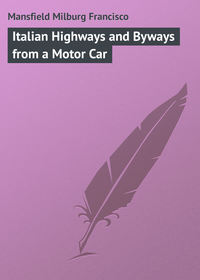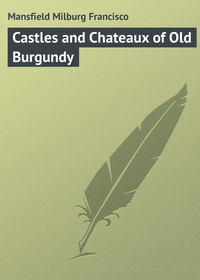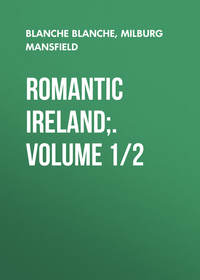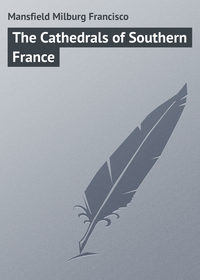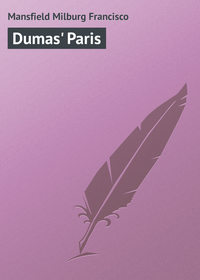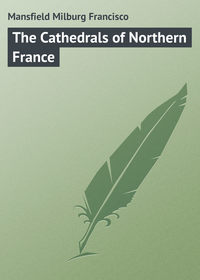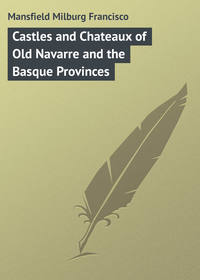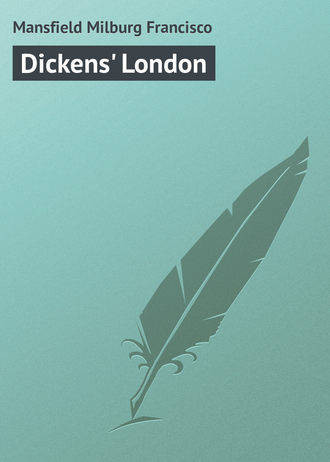 полная версия
полная версияDickens' London
No mention of London riverside attractions can be made without enlarging somewhat upon the sordid and unsavoury (in more senses than one) Limehouse Hole and Limehouse Reach.
Redolent of much that is of the under world, these localities, with indeed those of all the waterside round about, have something of the fascination and glamour which surrounds a foreign clime itself. Here in "Brig Place," evidently an imaginary neighbourhood, Dickens placed the genial hook-armed Cuttle, and he must not only have studied these types upon the spot, but must have been enamoured of the salty sentiment which pervades the whole region from the notorious Ratcliffe Highway on the north, now known by the more respectable name of St. George's Street, made famous in the "Uncommercial Traveller," to the "Stairs" near Marshalsea on the south, where Dickens used to stroll of a morning before he was allowed to visit his father in the prison, and imagine those "astonishing fictions about the wharves and the Tower."
It was at Limehouse, too, that Dickens' godfather, Huffam, a rigger and sailmaker, lived, and with whom Dickens was so fond, when a boy, of making excursions roundabout the "Hole" and the "Reach" with their "foul and furtive boats."
Returning westward one finds, adjoining Somerset House, the famed Waterloo Bridge, great as to its utility and convenience, and splendid as to its appointments. "An exquisite combination of all that is most valuable in bridge architecture," wrote Knight in 1842; called also by Canova, whom of late it is become the custom to decry, the finest bridge in Europe, and worth coming from Rome to see. It is the masterwork of one John Rennie, a Scotch schoolmaster, and was completed in 1817, and named after the decisive event achieved by His Majesty's forces two years before. It has ever been the one short cut into South London from all the west central region, and is the continuation of the roadway across the Strand – Wellington Street – intimately associated with Dickens by the building which formerly contained the offices of Household Words and the London chambers of Dickens' later years.
Blackfriars Bridge follows immediately after the Temple Gardens, but, unlike Waterloo or the present London Bridge, is a work so altered and disfigured from what the architect originally intended, as to be but a slummy perversion of an inanimate thing, which ought really to be essentially beautiful and elegant as useful.
At this point was also the embouchement of the "Fleet," suggestive of irregular marriages and the Fleet Prison, wherein Mr. Pickwick "sat for his picture," and suffered other indignities.
As Dickens has said in the preface to "Pickwick," "legal reforms have pared the claws by which a former public had suffered." The laws of imprisonment for debt have been altered, and the Fleet Prison pulled down.
A little further on, up Ludgate Hill, though not really in the Thames district, is the "Old Bailey," leading to "Newgate," whereon was the attack of the Gordon Rioters so vividly described in Chapter LXIV. of "Barnaby Rudge." The doorway which was battered down at the time is now in the possession of a London collector, and various other relics are continually finding their way into the salesroom since the entire structure was razed in 1901.
Southwark Bridge, an ordinary enough structure of stone piers and iron arches, opened another thoroughfare to South London, between Blackfriars and the incongruous and ugly pillar known as the Monument, which marks the starting-point of the great fire of 1666, and is situated on the northerly end of the real and only "London Bridge" of the nursery rhyme.
As recorded, it actually did fall down, as the result of an unusually high tide in 1091. As the historian of London Bridge has said, "a magnificent bridge is a durable expression of an ideal in art, whether it be a simple arch across an humble brook, or a mighty structure across a noble river."
The history of London Bridge is a lengthy account of itself, and the period with which we have to deal carries but a tithe of the lore which surrounds it from its birth.
It was said by Dion Cassius that a bridge stood here in the reign of Claudius, but so far into antiquity is this (44 A. D.), that historians in general do not confirm it. What is commonly known as "Old London Bridge," with its houses, its shops, and its chapels, a good idea of which is obtained from the sixth plate of Hogarth's "Marriage á la Mode," was a wonderfully impressive thing in its day, and would be even now, did its like exist.
The structures which roofed the bridge over, as it were, were pulled down; and various reparations made from time to time preserved the old structure until, in 1824, was begun the present structure, from the designs of Rennie, who, however, died before the work was begun. It was opened by William IV. and Queen Adelaide in 1831, and occupies a site two hundred or more feet further up the river than the structure which it replaced, the remains of which were left standing until 1832. Thus it is likely enough that Dickens crossed and recrossed this famous storied bridge, many times and oft, when his family was living in Lant Street, in Southwark, while the father of the family was languishing in the iron-barred Marshalsea.
As Laurence Sterne has truly said, "Matter grows under one's hands. Let no man say, 'Come, I'll write a duodecimo.'" And so with such a swift-flowing itinerary as would follow the course of a river, it is difficult to get, within a reasonably small compass, any full résumé of the bordering topography of the Thames. All is reminiscent, in one way or another, of any phase of London life in any era, and so having proceeded thus far on the voyage without foundering, one cannot but drop down with the tide, and so to open sea.
Below the metropolis of docks and moorings the river widens to meet the sea, so that any journey of observation must perforce be made upon its bosom rather than as a ramble along its banks.
Blackwall, with its iron-works; Woolwich, with its arsenal; and Greenwich, with its hospital and observatory, are all landmarks by which the traveller to London, by sea, takes his reckoning of terra firma.
The shipping of the Orient, the Baltic, the Continent, or the mere coaster, with that unique species of floating thing, the Thames barge, all combine in an apparently inextricable tangle which only opens out in the estuary below Gravesend, which, with its departed glory and general air of decay, is the real casting-off point of seagoing craft. Here the "mud-pilot," as the river pilot is locally known, is dropped, and the "channel pilot" takes charge, and here last leave-takings are said and last messages left behind.
Opposite Gravesend, from where Dickens first set sail for America, is Tilbury Fort, a reminder of the glories of England's arms in the days of Elizabeth. It may be said to be the real outpost of London. Here passing from the "Lower Hope" into "Sea Reach," we fairly enter upon the estuary of the Thames. Here the river has rapidly expanded into an arm of the sea, having widened from two hundred and ninety yards at London Bridge to perhaps four and a half miles at the "London Stone" by Yantlet Creek, where the jurisdiction of the Corporation of London ends.
To the north the Essex shore trends rapidly away toward Yarmouth; to the south straight to the eastern end of the English Channel, past the historic Medway, with Gad's Hill Place and Higham.
Beyond is Strood, Rochester, Chatham, Maidstone, Canterbury, and Broadstairs, and with the latter place one takes leave, as it were, of England, Dickens, and his personal and literary associations therewith.
MANNERS AND CUSTOMS
London is not a single city, but rather a sequence or confederation of cities. In its multifarious districts there is not only a division of labour, but a classification of society – grade rising above grade, separate yet blended – "a mighty maze, but not without a plan." Says one of her most able and observing historians, "were we not accustomed to the admirable order that prevails, we should wonder how it was preserved." The regular supply of the various food markets alone is a truly wonderful operation, including all the necessaries and, what the Londoner himself supposes to be, all the luxuries of life. The method of distribution is truly astonishing, and only becomes less so to the liver in the midst of it all by reason of his varying degree of familiarity therewith. As to the means of sustenance, no less than livelihood, of a great mass of its population, that is equally a mystery. All among the lower classes are not Fagins nor yet Micawbers. How do the poor live who rise in the morning without a penny in their pockets? How do they manage to sell their labour before they can earn the means of appeasing hunger? What are the contrivances on which they hit to carry on their humble traffic? These and similar questions are those which the economist and the city fathers not only have been obliged to heed, but have got still greater concern awaiting them ahead. Poverty and its allied crime, not necessarily brutalized inherent criminal instinct, but crime nevertheless, are the questions which have got to be met broadly, boldly, and on the most liberal lines by those who are responsible for London's welfare.
During the first half of the nineteenth century the economists will tell one that England's commercial industries stagnated, but perhaps the prodigious leaps which it was taking in the new competitive forces of the new world made this theory into a condition.
In general, however, the tastes of the people were improving, and with the freedom of the newspaper press, and the spread of general literature, there came a desire for many elegancies and refinements hitherto disregarded.
The foundation of the British Museum in 1750, by the purchase of the library and collection of Sir Hans Sloane, and Montagu House, gave an early impetus to the movement, which was again furthered when, in 1801, George III. presented a collection of Egyptian antiquities, and in 1805 and 1806 were purchased the Townley and Elgin marbles respectively. The Museum continued to increase until, in 1823, when George IV. presented his father's library of sixty-five thousand volumes, Montagu House was found to be quite inadequate for its purpose, and the present building, designed by Sir Robert Smirke, and completed in 1827, was erected on its site. In making this gift, the king said, "for the purpose of advancing the literature of his country, and as a just tribute to the memory of a parent whose life was adorned with every public and private virtue."
The magnificent reading-room was not constructed until 1855-57, but it became a "felt want" from the time when George IV. made his valuable presentation to the Museum. The great "reading age" was then only in its infancy.
Early in 1830 George IV. fell ill, and on the 25th of June he died. During his regency, although he himself had little to do with the matter, his name was associated with many splendid triumphs, by the marvellous progress of intellect, and by remarkable improvements in the liberal arts. With fine abilities and charming manners, England might have been proud of such a king, but he squandered his talents for his own gratification; alienated himself from all right-minded men; lived a disgraceful life, and died the subject of almost universal contempt. His epitaph has been written thus: "He was a bad son, a bad husband, a bad father, a bad subject, a bad monarch, and a bad friend."
The memory of old London is in no way kept more lively than by the numerous City Companies or Guilds. Established with a good purpose, they rendered useful enough service in their day, but within the last half-century their power and influence has waned, until to-day but three, of the eighty or more, are actually considered as Trading Companies, – the Goldsmiths', the Apothecaries' and the Stationers'.
The first companies, or fraternities, of Anglo-Saxon times gradually evolved themselves into the positive forms in which they have endured till to-day. Just when this evolution came about is obscure. An extinct "Knighten Guild" was licensed by Edgar, a reminiscence of which is supposed to exist to-day in Nightingale Lane, where the Guild was known to have been located.
The oldest of the City Companies now existing is the Weavers' Company, having received its charter from Henry II. Though licensed, these trade organizations were not incorporated until the reign of Edward III., who generously enrolled himself as a member of the Merchant Tailors.
At this time it was ordained that all artificers should choose their trade, and, having chosen it, should practise no other; hence it was that these "Guilds" grew to such a position of wealth and influence, the ancient prototype, doubtless, of the modern "labour unions."
The twelve great City Companies, whose governors ride about in the lord mayor's procession of the 9th of November of each year, are, in order of precedence, ranked as follows: Mercers, Grocers, Drapers, Fishmongers, Goldsmiths, Skinners, Merchant Tailors, Haberdashers, Salters, Ironmongers, Vintners, Cloth-workers.
Allied with these are eighty odd other companies divided into three classes:
I. Those exercising a control over their trades: Goldsmiths, Apothecaries.
II. Those exercising the right of search or marking of wares: the Stationers, at whose "hall" must be entered all books for copyright; the Gunmakers, who "prove" all London-made guns; Saddlers, Pewterers, and Plumbers.
III. Companies into which persons carrying on certain occupations are compelled to enter: Apothecaries, Brewers, Builders, etc.
The "halls," as they are called, are for the most part extensive quadrangular buildings with a courtyard in the centre.
The most pretentious, from an architectural point of view, are Goldsmiths' Hall in Foster Lane, and Ironmongers' Hall in Fenchurch Street.
Fishmongers' Hall, at the northwest angle of London Bridge, built in 1831, is a handsome structure after the Greek order, with a fine dining-room. The Merchant Tailors' Hall, in Threadneedle Street, has a wonderful banquet-room, with portraits of most of the Kings of England, since Henry VIII., adorning its walls.
Stationers' Hall will perhaps be of the greatest interest to readers of this book. All who have to do with letters have a certain regard for the mysticism which circles around the words, "Entered at Stationers' Hall."
The Stationers' Company was incorporated in 1557; it exercised a virtual monopoly of printing almanacs under a charter of James I. until 1775, when the judges of the Court of Common Pleas decided that their professed patent of monopoly was worthless, the Crown having no power to grant any such exclusive right. Doubtless many another archaic statute is of a like invalidity did but some protestful person choose to take issue therewith. The number of freemen of the company is about 1,100; that of the livery about 450. Printers were formerly obliged to be apprenticed to a member of the company, and all publications for copyright must be entered at their hall. The register of the works so entered for publication commenced from 1557, and is valuable for the light it throws on many points of literary history. The Copyright Act imposes on the company the additional duty of registering all assignments of copyrights. The charities of the company are numerous. In Dickens' time Almanac Day (November 22d) was a busy day at the hall, but the great interest in this species of astrological superstition has waned, and, generally speaking, this day, like all others, is of great quietude and repose in these noble halls, where bewhiskered functionaries amble slowly through the routine in which blue paper documents with bright orange coloured stamps form the only note of liveliness in the entire ensemble.
The Goldsmiths' Company assays all the gold and silver plate manufactured in the metropolis, and stamps it with the "hall-mark," which varies each year, so it is thus possible to tell exactly the year in which any piece of London plate was produced.
The out-of-door amusements of society were at this time, as now, made much of. The turf, cricket, and riding to hounds being those functions which took the Londoner far afield. Nearer at home were the charms of Richmond, with its river, and the Star and Garter, and the Great Regatta at Henley, distinctly an affair of the younger element.
Tea-gardens, once highly popular, had fallen into disrepute so far as "society" was concerned. Bagnigge Wells, Merlin's Cave, the London Spa, Marylebone Gardens, Cromwell's Gardens, Jenny's Whim, were all tea-gardens, with recesses, and avenues, and alcoves for love-making and tea-drinking, where an orchestra discoursed sweet music or an organ served as a substitute. An intelligent foreigner, who had published an account of his impressions of England, remarked: "The English take a great delight in the public gardens, near the metropolis, where they assemble and drink tea together in the open air. The number of these in the capital is amazing, and the order, regularity, neatness, and even elegance of them are truly admirable. They are, however, very rarely frequented by people of fashion; but the middle and lower ranks go there often, and seem much delighted with the music of an organ, which is usually played in an adjoining building."
Vauxhall, the Arabia Felix of the youth of the eighteenth and nineteenth centuries, was still a fashionable resort, "a very pandemonium of society immorality," says a historian. This can well be believed if the many stories current concerning "prince, duke, and noble, and much mob besides," are accepted.
"Here the 'prentice from Aldgate may ogle a toast!Here his Worship must elbow the knight of the post!For the wicket is free to the great and the small; —Sing Tantarara —Vauxhall! Vauxhall!"The first authentic notice of Vauxhall Gardens appears in the record of the Duchy of Cornwall in 1615, when for two hundred years, through the changes of successive ages, there was conducted a round of gaiety and abandon unlike any other Anglo-Saxon institution. Open, generally, only during the summer months, the entertainment varied from vocal and instrumental music to acrobats, "burlettas," "promenades," and other attractions of a more intellectual nature, and, it is to be feared, likewise of a lesser as well.
The exhibition usually wound up with a display of fireworks, set off at midnight. From 1830 to 1850 the gardens were at the very height of their later festivity, but during the next decade they finally sank into insignificance, and at last flickered out in favour of the more staid and sad amusements of the later Victorian period.
As for the indoor pleasures of society at this time, there were the theatre, the opera, and the concert-room. Dining at a popular restaurant or a gigantic hotel had not been thought of. There were, to be sure, the "assembly-rooms" and the "supper-rooms," but there were many more establishments which catered to the pleasures of the masculine mind and taste than provided a fare of food and amusement which was acceptable to the feminine palate.
Of the men's clubs, Brookes' and White's had long been established, and, though of the proprietary order, were sufficiently attractive and exclusive to have become very popular and highly successful. The other class were those establishments which fulfil the true spirit and province of a club, – where an association of gentlemen join together in the expense of furnishing accommodation of refreshment and reading and lounging rooms. This was the basis on which the most ambitious clubs were founded; what they have degenerated into, in some instances, would defy even a rash man to attempt to diagnose, though many are still run on the conservative lines which do not open their doors to strangers, even on introduction, as with the famous Athenæum Club.
Other clubs, whose names were already familiar in the London of Dickens' day, were the Carleton, Conservative, Reform, University, and perhaps a score of others.
As is well known, Dickens was an inordinate lover of the drama, a patron of the theatre himself, and an amateur actor of no mean capabilities. As early as 1837 he had written an operetta, "The Village Coquettes," which he had dedicated to Harley. It was performed, for the first time, on December 6, 1836, at the St. James' Theatre. A London collector possesses the original "hand-bill," announcing a performance of "Used Up" and "Mr. Nightingale's Diary," at the Philharmonic Hall, Liverpool, in 1852, in which Dickens, Sir John Tenniel, and Mark Lemon took part; also a playbill of the performance of "The Frozen Deep," at the "Gallery of Illustration," on Regent Street, on July 4, 1857, "by Charles Dickens and his amateur company before Queen Victoria and the Royal Family."
The painting (1846) by C. R. Leslie, R. A., of Dickens as Captain Boabdil, in Ben Jonson's play of "Every Man in His Humour," is familiar to all Dickens lovers.
The theatres of London, during the later years of Dickens' life, may be divided into two classes: those which were under "royal patronage," and those more or less independent theatres which, if ever visited by royalty, were favoured with more or less unexpected and infrequent visits.
Of the first class, where the aristocracy, and the royal family as well, were pretty sure to be found at all important performances, the most notable were "Her Majesty's," "The Royal Italian Opera House," "The Theatre Royal, Drury Lane." Of the latter class, the most famous – and who shall not say the most deservedly so – were the "Haymarket Theatre," "The Adelphi," "The Lyceum," and the "St. James' Theatre."
"Her Majesty's Theatre," on the western side of the Haymarket, was the original of the two Italian opera-houses in London; it was built in 1790, on the site of an older theatre, burnt down in 1867, and rebuilt in 1869. The freehold of some of the boxes was sold for as much as £8,000 each. The opera season was generally from March to August; but the main attractions and the largest audiences were found from May to July. The "Royal Italian Opera House" occupied the site of the former Covent Garden Theatre, as it does to-day, and was built in 1858 on the ruins of one destroyed by fire. The building is very remarkable, both within and without. Italian opera was produced here with a completeness scarcely paralleled in Europe. When not required for Italian operas, the building was often occupied by an "English Opera Company," or occasionally for miscellaneous concerts. The "Floral Hall" adjoins this theatre on the Covent Garden side. "Drury Lane Theatre," the fourth on the same site, was built in 1812; its glories live in the past, for the legitimate drama now alternates there with entertainments of a more spectacular and melodramatic character, and the Christmas pantomimes, that purely indigenous English institution. The "Haymarket Theatre," exactly opposite "Her Majesty's," was built in 1821; under Mr. Buckstone's management, comedy and farce were chiefly performed. The "Adelphi Theatre," in the Strand, near Southampton Street, was rebuilt in 1858, when it had for a quarter of a century been celebrated for melodramas, and for the attractiveness of its comic actors. The "Lyceum Theatre," or "English Opera House," at the corner of Wellington Street, Strand, was built in 1834 as an English opera-house, but its fortunes were fluctuating, and the performances not of a definite kind. This was the house latterly taken over by Sir Henry Irving. The "Princess' Theatre," on the north side of Oxford Street, was built in 1830; after a few years of opera and miscellaneous dramas, it became the scene of Mr. Charles Kean's Shakespearian revivals, and now resembles most of the other theatres. "St. James' Theatre," in King Street, St. James', was built for Braham, the celebrated singer. "The Olympic" was a small house in Wych Street, Drury Lane, now destroyed. "The Strand Theatre" was famous for its burlesque extravaganzas, a form of theatrical amusement which of late has become exceedingly popular. The "New Globe Theatre" (destroyed so late as 1902) and "The Gaiety" (at the stage entrance of which are the old offices of Good Words, so frequently made use of by Dickens in the later years of his life), and "The Vaudeville," were given over to musical comedy and farce. "The Adelphi," though newly constructed at that time, was then, as now, the home of melodrama.


